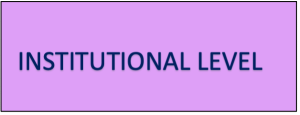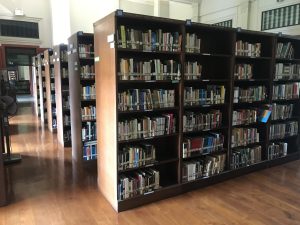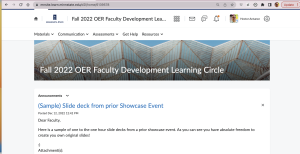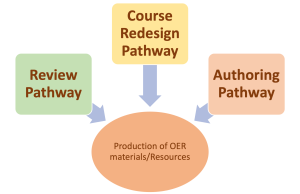3 OER Learning Circle Structure and Participation
Feedback from a Learning Circle Participant:
“My big takeaways concern time management and the effectiveness of the Learning Circle experience. I would caution someone who is new to OER that it is a major time commitment to both search for appropriate material as well as to incorporate it into course design. Learning Circles are a good way to begin as you can get lots of advice from others and gain access to the D2L course with all the links and guidelines”
Josh Berkenpas
Spring 2020
Basic Learning Circle Structure:
The structure of the OER Learning Circle Model focuses on three project areas of faculty involvement, or pathways. The identified pathways depend on whether the model is being used at the institutional level or at the system level.
The Learning Circle Model is first and foremost a Librarian/ Faculty driven initiative that:
- Meets faculty where they are individually in the OER awareness and adoption process
- Increases faculty awareness of OER opportunities
- Increases adoption of OER and the redesign of courses with OER, and
- Increases the authoring of OER.

At the institutional level the three pathways are;
- Review Pathway: faculty search for and review OER materials to adopt or adapt for their course.
- Course Redesign Pathway: faculty have already selected resources to use for their course and now redesign their course and contents around the selected OER.
- Authoring Pathway: creating ancillary materials to accompany existing OER, or the authoring of a textbook or other type of OER to be used as the core educational resource for their course.

At the system level the typical pathways;
- Course Redesign Pathway: review and selection of OER being done with a paid stipend from participation in a system sponsored OEN webinar and review of resources located in the Open Textbook Library (OTL).
- Authoring Pathway: creation of ancillary materials or a textbook or core course content resources.
- OER Leaders Program: previous system offered OER Learning Circle participants are mentored through a OER Learning Circle session as a collaborating facilitator of the Learning Circle and create their own online course room to lead and support faculty at their institutions using my OER Learning Circle Model. [1], [2]

Image representing the typical pathways for developing OER materials/resources The typical pathways for developing OER materials/resources. Image created by Giovanni Antunez using Microsoft, Licensed CC BY-SA 4.0 International.
Six key requirements for participants of the Learning Circles:
- Faculty attend 80% of scheduled cross disciplinary Learning Circle meetings.
- Each Learning Circle meeting begins with a “sharing session” (The Learning Circle).
- Faculty create, submit, and update weekly work-plans and journals.
- Faculty present their final work results to colleagues.
- Faculty are supported and keep materials and work organized within the structure of a online support course room within a LMS (I use D2L Brightspace)
- Participants must complete their project in order to be paid a stipend for their work. The OER textbook review pathway stipend is between $200.00 – $500.00 Both the course redesign pathway and the authoring pathway recipients receive .5 release credit stipends for their work (amount is based on each participants contractual wage).
Faculty Participation:
The Learning Circle Model is first and foremost a Librarian/ Faculty driven initiative where faculty can meet in collaborative, cross disciplinary learning circles. Faculty enjoy the cross disciplinary structure of the Learning Circles and value the opportunity to learn how faculty in other
 |
| “Bookshelves in Faculty of Arts Library, Chulalongkorn University.” Wikimedia Commons, CC BY-SA 4.0 |
content areas teach and design their courses. The Learning Circles have built new bridges of communication and collaboration across disciplines, content areas, departments, and institutions. Two key elements make this process succeed; the Support Course Room, and the Learning Circles.
Support Course Room
A critical part of this model is the LMS faculty Support Course Room. The Support Course Room provides Learning Circle participants with a virtual online environment where they interact with each other and with the Learning Circle facilitator. Each week each participant submits their work-plan for facilitator feedback and participate in a brief weekly discussion forum where they share a “Pearl” (“Aha” moment or discovery) for the week.
 |
| Screen picture of an OER faculty Learning Circle. Picture taken directly from D2L Brightspace Courseroom. Image not licensed. |
The Learning Circles and the Support Course Room also offer faculty those support services that faculty need to succeed in their work;
- various OER links and resources
- time saving templates for organization of materials,
- collaboration options
- librarian support,
- administrative support
Learning Circles:
OER Learning Circle Model focuses on three project areas of faculty involvement, or pathways. All three of these pathways require faculty to meet the same weekly work objectives, but with different end outcomes.
Review Pathway:
The end outcome for the review pathway is to have reviewed OER resources and to have selected a OER to use in their course or courses. Faculty on the review pathway will complete a work plan, a textbook comparison template and a review rubric (BC Campus Criteria Checklist). [3] At the system level OER material reviews are done through the OEN (Open Education Network) Webinars which are scheduled four to five times each academic year.[4] Faculty are paid a $200.00 stipend for attending the webinar and then writing a review of one of the resources in the Open Textbook Library at the University of Minnesota. [5]Faculty are permitted to attend up to two webinars and write up to two reviews to receive a stipend. At the institutional level faculty share the resources that they have found with the other members of their semester Learning Circle cohort. This is usually done at the final Learning Circle meeting for each semester session.[6]
Course Redesign Pathway:
The end outcome for the redesign pathway is to have created a LMS course room or course written as a hard copy ( Example: complete course written in the Learning Objective and Course Matrix Template) that contains specified components and to share that course with the faculty in their department, or in Opendora (if at the MinnState system level they must share in Opendora)[7] and license that course with a Creative Commons License.[8] This helps to move OER adoption from the level of the individual faculty member to the level of the department and make the OER efforts more sustainable. At the system level faculty from all of the Learning Circles for that academic year share their completed projects at a annual April Showcase Event. At the institutional level this is often done at the final Learning Circle meeting for each semester session.[9]
Authoring Pathway:
The end outcome for the authoring pathway is to have created a core or primary OER for their course, or ancillary materials to accompany an existing OER resource. Examples could be a textbook or curation of resources, test banks, portfolios projects, PowerPoint’s, worksheets, digital ancillaries or interactive activities.[10] Faculty are expected to share these resources with the faculty in their departments, institutions and / or in Opendora (if at the MinnState system level they must share in Opendora). They license all resources with Creative Commons licenses. At the system level faculty from all of the Learning Circles for that academic year share their completed projects at an annual April Showcase Event. At the institutional level this is often done at the final Learning Circle meeting for each semester session.
 |
| OER Learning Circle Model – Pathways. Image created using Microsoft Word by Giovanni Antunez, Licensed CC BY-SA 4.0 |
Faculty on all three pathways work in facilitated, cross disciplinary, collaborative, Learning Circles with other faculty members where they share ideas and support each other through their chosen pathway.
Faculty can participate in one or both two semester long Learning Circles which run for 10 consecutive weeks, and in a summer session which runs for 5 weeks. All three sessions start with a introductory week which is in addition to the standard 10 and 5 weeks of the sessions.
- In the face to face sessions faculty meet, share “Pearls”, and work together in groups or independently during that 2-3 hour time period, meeting for two to three hours the same day and time each week.
- In the virtual sessions faculty meet for one hour per week in a group Learning Circle via zoom and share “Pearls” and listen to guest speakers, and then schedule all of their OER work independently within their own selected time frames.
For both formats faculty schedule their time to work and their weekly work goals on the ten week work plan. They then also journal on their Ten Week Work Plan and submit it each week in the Online D2L support course room for feedback from the OER Learning Circle facilitator.
Summer sessions meet for five consecutive weeks ending just before the 4th of July using the same day and time format with each Learning Circle meeting for three face to face hours and committing to at least one hour of independent work outside of the Learning Circles (if sessions are face to face) or for one hour per week in a virtual face to face zoom Learning Circle if the sessions are virtual Learning Circles).
Recently an “Introductory Learning Circle” has been added to each of these offering formats. This session is held one week before the official start of the ten or five week sessions. This is very helpful for faculty that are attending a Learning Circle for the first time. It allows them to become familiar with the structure of the D2L support course room and to meet the other faculty in that cohort before the official start date.
Key Takeaways
- The structure of the OER Learning Circle Model focuses on three project areas of faculty involvement.
- Participants apply and are approved by an administrative group to attend the Learning Circles
- The Learning Circle Model is a Librarian/ Faculty driven initiative
- The structure of the Learning Circles Program is based on two core components: the support course room and the circle meetings.
- Key requirements drive the programs
- Participants are paid a stipend for their completed work
- Pikula, K. (Feb. 28, 2020). OER Learning Circles with Karen Pikula. Open Education Network. You tube: https://www.youtube.com/watch?v=2Qis2ybDwhQ ↵
- The SAC OER Faculty Work Group. (Spring 2016). Open Educational Resources Frequently Asked Questions (Extended Version), pdf document. From https://sac.edu/AcademicAffairs/DistanceEd/Documents/OER_FAQ_Extended.pdf ↵
- BC Campus. (n.d.). Tools for Finding OER. BCOEL resources and tools for finding open education resources and assessing OER repositories. OER Repository Rubric. BC Open Education Librarians. From https://bcoel.ca/resources/oer-finding-tools/ ↵
- Open Education Network (OEN). Knowledge is meant to be shared. From https://open.umn.edu/oen ↵
- The Open Education Network (Open Textbook Library). (n.d.). Center for Open Education in the University of Minnesota’s College of Education and Human Development. University of Minnesota. From https://open.umn.edu/opentextbooks ↵
- Pikula, K. (Dec 14, 2020). Minnesota State OER Faculty Development Learning Circles, presentation at the Massachusetts Department of Higher Education. Power point found as 2020-12-14 OER Learning Circle Model Presentation. ↵
- Opendora. (n.d.). Opendora, Minnesota state. From https://askus.minnstate.edu/app/answers/detail/a_id/5513/~/opendora ↵
- Creative Commons. (n.d.). About the licenses. From https://creativecommons.org/licenses/ ↵
- ASA (Academic and Student Affairs at Minnesota State) Newsletter. (n.d.). OER project showcase. From https://asanewsletter.org/2023/03/30/2023-oer-project-showcase-how-faculty-are-helping-students-save-money/#more-46265 ↵
- Todorinova L, Wilkinson ZT. (Nov, 2020). Incentivizing faculty for open educational resources (OER) adoption and open textbook authoring. Journal of academic librarianship, 46(6):102220. From https://www.ncbi.nlm.nih.gov/pmc/articles/PMC7427534/ ↵
The acronym OER stands by "Open Educational Resources"
The Learning Circle (LC) Model and Process were created to allow participants to be met where they are in the learning process. The author sometimes uses only the words 'model' or 'process' and sometimes both.
The faculty search for and review OER materials to adopt or adapt for their course.
Redesign Pathway: the term refers to faculty have already selected resources to use for their course and now 'redesign' their course and contents around the selected OER.
In this case, the instructor is writing its OER (Open Educational Resources) materials using their own experience, or expertise.
